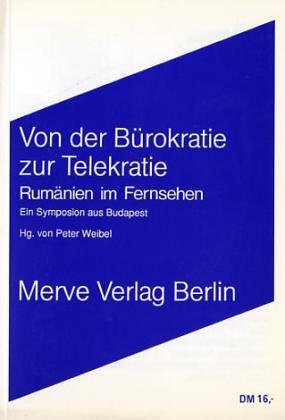Keiko Sei (ed.): Von der Bürokratie zur Telekratie. Rumänien im Fernsehen. Ein Symposion aus Budapest (1990) [German]
Filed under book | Tags: · 1989, mass media, media, media theory, revolution, romania

The publication resulting from the symposium The Media Are With Us!: The Role of Television in the Romanian Revolution which took place at Mücsarnok, Budapest, on 6-7 April 1990.
Contributions by Paolino Accolla, László Beke, Magda Cârneci, Mihaela Cristea, Serge Daney, Jean-Paul Fargier, Vilém Flusser, Ingo Günther, Veijo Hietala, Ari Honka-Hallila, Erkki Huhtamo, Derrick de Kerckhove, Richard Kriesche, Geert Lovink, Margaret Morse, Morgan Russel, Jeffrey Shaw, Tjebbe van Tijen, Paul Virilio, and Peter Weibel.
Translated by Almuth Carstens, Birger Ollrogge and Monika Rauschenbach
Publisher Merve, Berlin, 1990
Internationaler Merve-Diskurs series, 157
ISBN 3883960772, 9783883960777
165 pages
via Neda Genova
Review: Eveline Lubbers (Mediamatic, 1991).
PDF (8 MB)
See also video documentary from the event.
Comment (0)thresholds, 41: Revolution! (2013)
Filed under journal | Tags: · activism, architecture, archive, city, media, memory, politics, protest, public space, revolution, urbanism

“What actions are prompted by revolution in the space of the city? Which publics take part in this struggle, and who are the agents that mobilize it? And after a revolution has subsided, how is it remembered, represented and memorialized? thresholds 41: REVOLUTION! turns to the history, design, and cultural production of the public realm as a site of dissensus. Rather than focusing on a specific revolutionary time and place, we have strived to include different periods and regions, organizing contributions in terms of the relations they establish between sites, actors, and contexts. In the essays and designs featured in these pages, political struggle often shifts established roles—agitators create new types of public space, designers become activists and fundraisers, individual figures fade in favor of collectives or groups, and actions are best remembered through misrepresentation. How do we write revolution, who writes it and for whom? And, in turn, how does urban conflict inform writing, design, and cultural production at large? Our authors, designers, and artists open up revolution as subject, as event, and as historiographical problem—a problem complicated by discrete actions, multiple publics, critical practices, and the politics of display and remembrance.”
Contributors: David Gissen, Robin Adèle Greeley, Britt Eversole, Arindam Dutta, Diane E. Davis and Prassana Raman, Mark Jarzombek, Thérèse F. Tierney, Kenneth Ip, Nasser Rabbat, Reinhold Martin, Tunney Lee and Lawrence Vale, Andrés Jaque Architects + Office for Political Innovation, Santiago Cirugeda + Recetas Urbanas, Nomeda Urbonas and Gediminas Urbonas, The Yes Men, Ateya Khorakiwala, Simone Brott, Andrés Estefane, Kelly Presutti, Mechtild Widrich, Montenegro Airways
Edited by Ana María León
Publisher SA+P Press / MIT Department of Architecture, Cambridge, MA, Spring 2013
Open Access
ISSN 1091-711X
ISBN 9780983508267
212 pages
PDF (13 MB)
Comment (0)Major Waldemar Fydrych: Lives of the Orange Men: A Biographical History of the Polish Orange Alternative Movement (2014)
Filed under book | Tags: · 1980s, activism, communism, dissent, happening, humour, poland, politics, protest, revolution, social movements

“In Communist Poland, Surrealism Paints You!!!
Between 1981 and 1989 in Wroclaw Poland, in an atmosphere in which dissent was forbidden and martial law a reality, the art-activist Orange Alternative movement developed and deployed their “socialist sur-realism” in absurd street-painting and large-scale performances comprising tens of thousands of people dressed as dwarves, in an effort to destabilize the Communist government. It worked. Beginning with the ‘dialectical painting’ of dwarves onto the patches of white paint all over the city’s walls, which uncannily marked the censorship of opposition slogans, the group moved on to both stage happenings and over-enthusiastically embrace official Soviet festivals in a way that transformed both of these into mass expressions of dissent. They illegally restaged the mass spectacle of the storming of the Winter Palace on the anniversary of the October Revolution using their own homemade tanks; organized patriotic gatherings in which anyone waving red flags or wearing red (or eating red borscht, or covering oneself in ketchup) was arrested; and inspired other Orange Alternative groups to appear across the country. Although the group existed to the left of the mainstream opposition of Solidarity, their art was a key, acknowledged factor in the overthrow of the Communist government.
Lives of the Orange Men tells the story of the movement’s main protagonists, and is the first stand-alone English-language account of the Orange Alternative, written autobiographically by is central figure, and featuring an appendix of newly translated key texts including Major’s “Manifesto of Socialist Surrealism,” a timeline of every Orange Alternative happening, and a new foreword from the Yes Men.”
Foreword by the Yes Men
Edited by Gavin Grindon
Translated by David French
Publisher Minor Compositions, 2014
Open Access
ISBN 9781570272691
328 pages
Review: Stewart Home (ArtReview, 2014).
See also other publications about the Orange Alternative
Comment (0)
